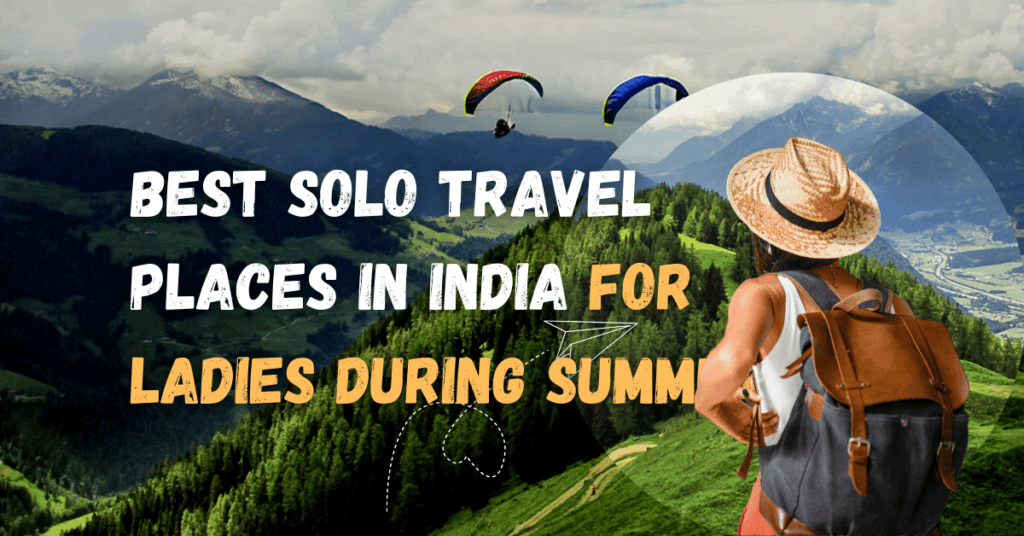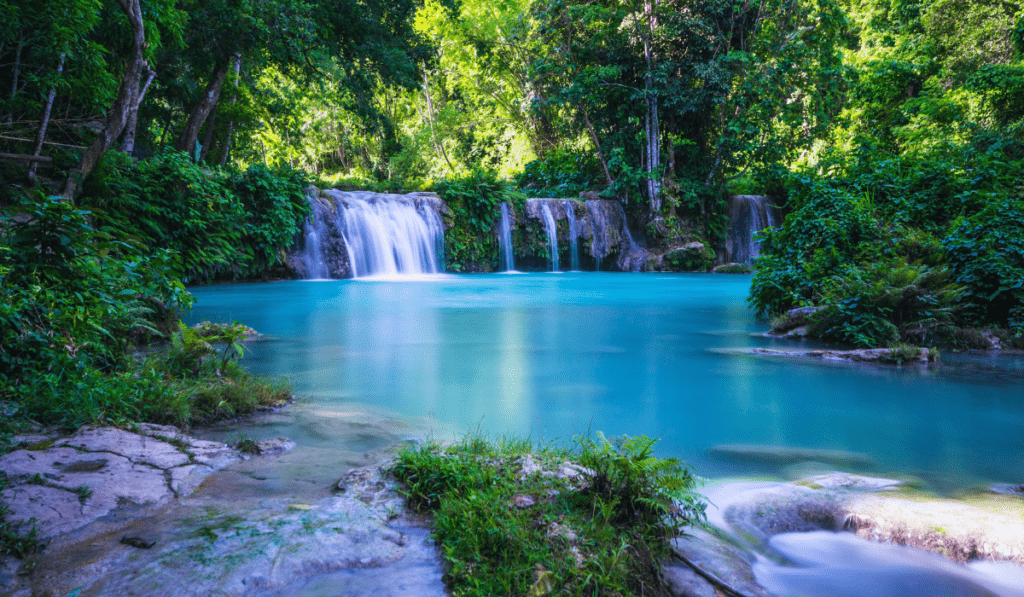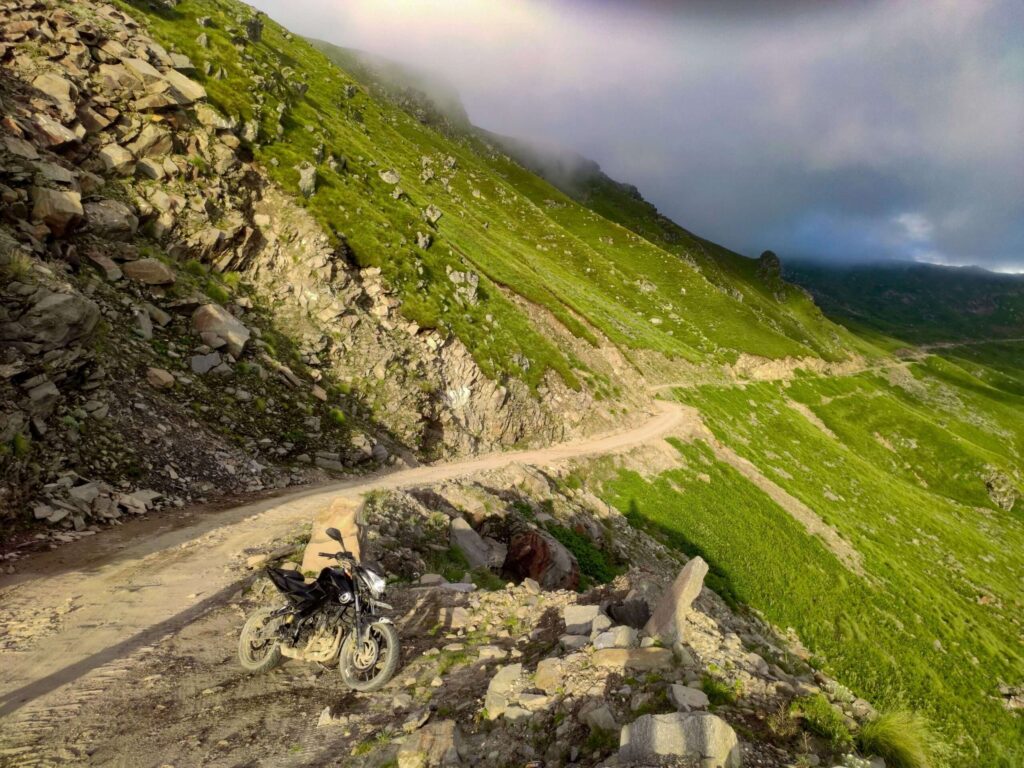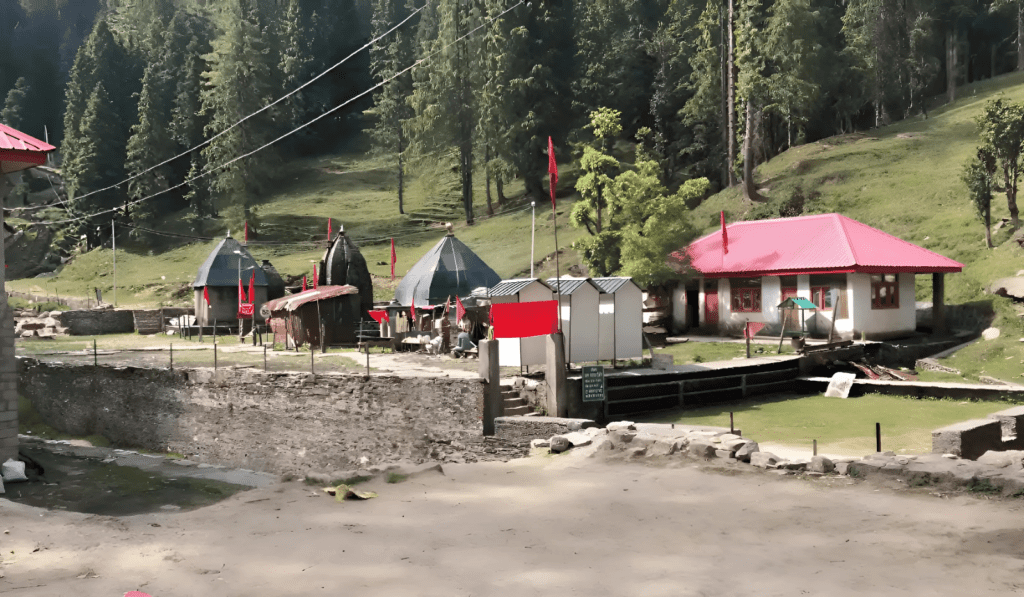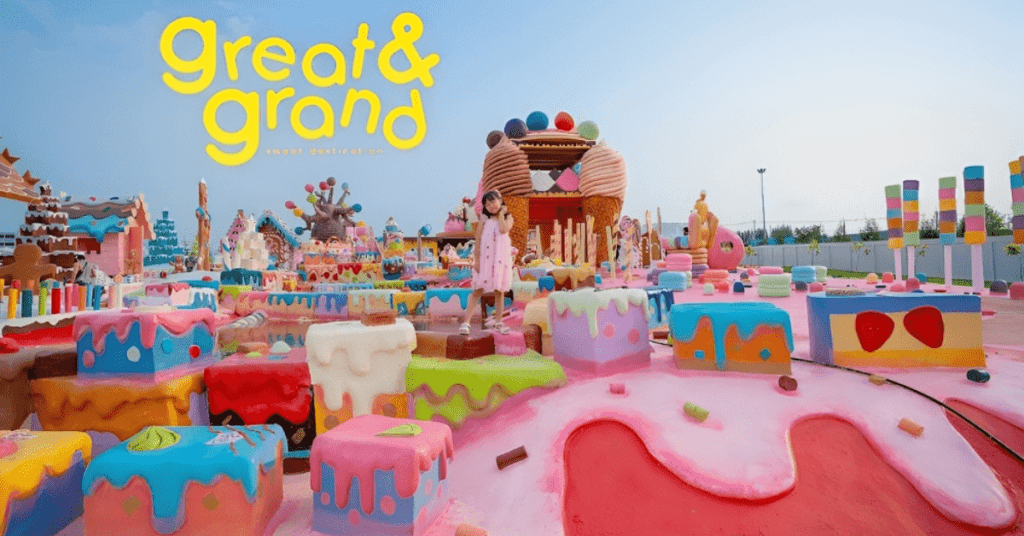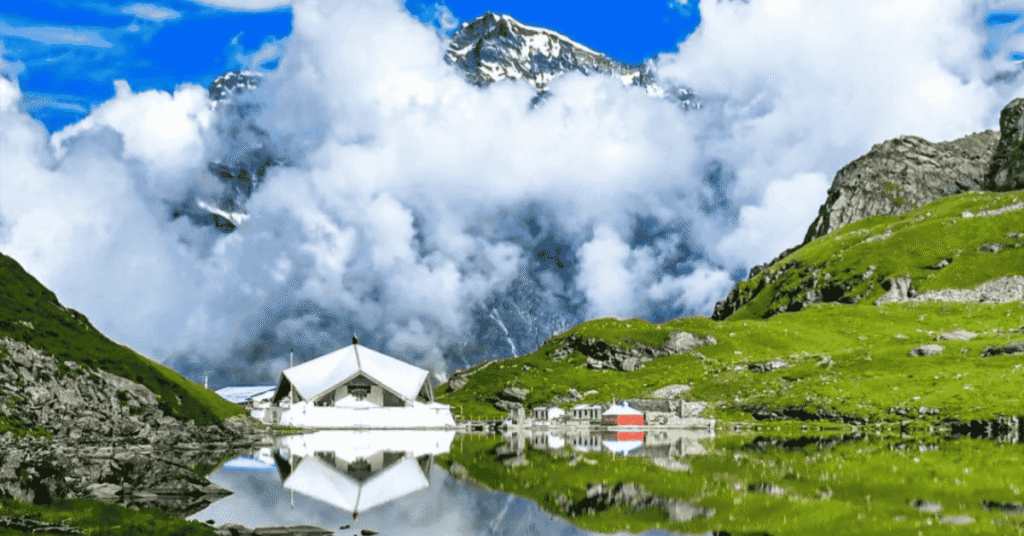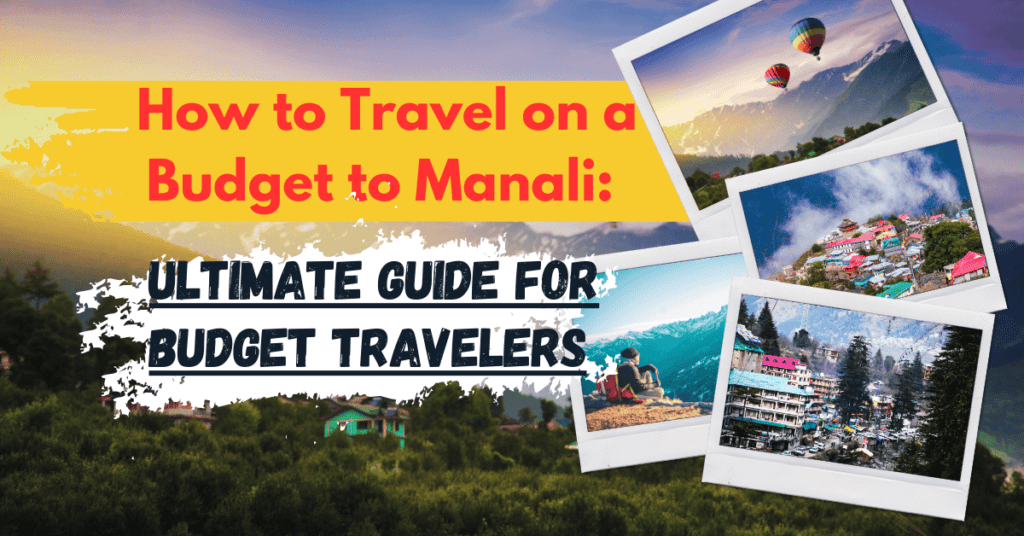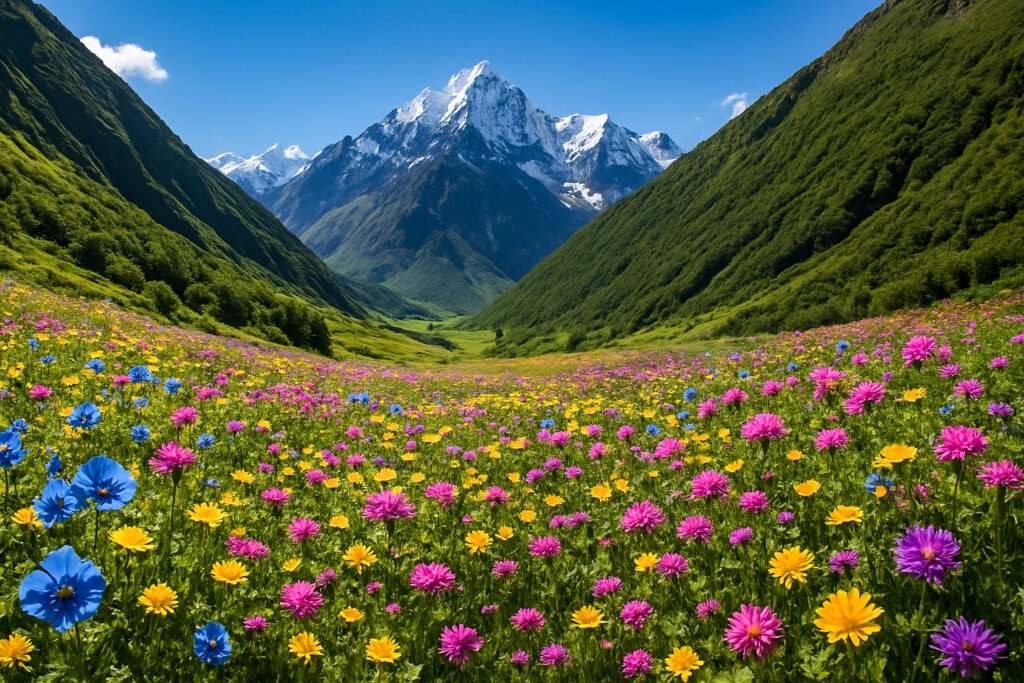
Imagine standing in a meadow full of colourful flowers, with the snow-capped Himalayan peaks all around you. That’s the Valley of Flowers trek National Park in Uttarakhand, India—a magical place straight out of a fairytale. A UNESCO World Heritage Site, it’s famous for over 600 species of flowers, rare wildlife, and breathtaking scenery. Whether you’re a kid looking for adventure, a parent planning a family trip, or a solo traveller in search of nature’s beauty, this guide will help you plan a perfect trip to Valley of Flowers in 2025.
We have combined travellers’ insights, first-hand trekking experiences and in-depth knowledge of Valley of Flowers to create your ultimate guide. It will provide you with step-by-step plans, budget-friendly tips, detailed itineraries, the latest costs, best time to visit, trek distances, safety guidance and answers to all your questions—ensuring that your adventure in Valley of Flowers is safe, unforgettable and truly enjoyable.
Where is the Valley of Flowers trek Located?
The Valley of Flowers trek is located within the Nanda Devi Biosphere Reserve in the western Himalayas, in the Chamoli district of the Uttarakhand state of India. It is located at an altitude of about 12,000 feet (3,658 meters) above sea level. Famous for its vibrant alpine flowers, the valley is a UNESCO World Heritage Site and a popular destination for nature lovers and trekkers.
Step-by-Step Guide: How to Reach Valley of Flowers trek
In this guide, you’ll get a step-by-step breakdown of how to reach the Valley of Flowers from major cities like Delhi, Haridwar, and Rishikesh.
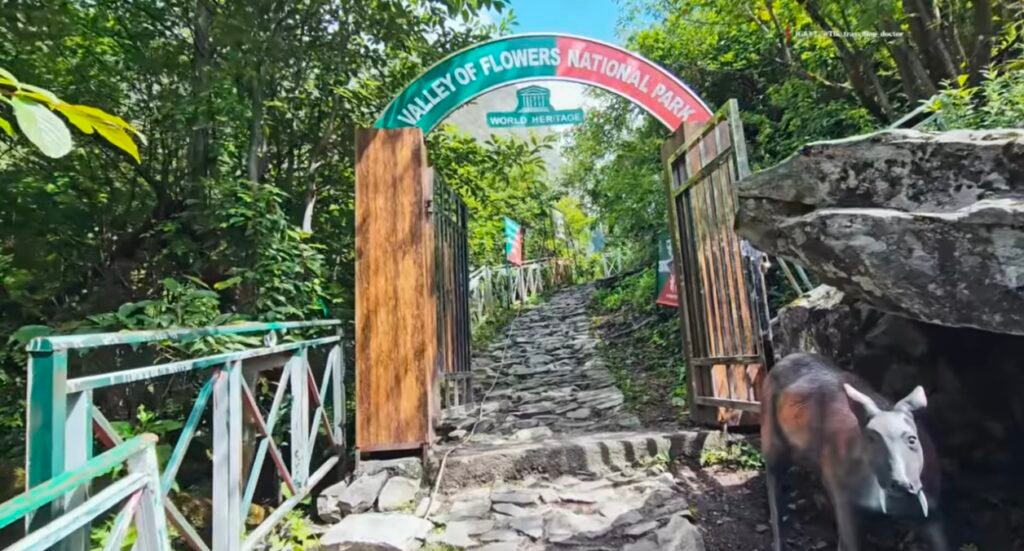
1. Reach Haridwar or Rishikesh (Starting Point of the Journey)
Your journey begins by reaching Haridwar or Rishikesh, the gateway towns to the Garhwal Himalayas.
By Train:
- Haridwar Junction (HW) and Rishikesh Railway Station are well connected to major cities like Delhi, Mumbai, Kolkata, and Varanasi.
- You can easily book overnight trains from Delhi.
By Air:
- The nearest airport is Jolly Grant Airport (Dehradun), located about 35 km from Rishikesh and 55 km from Haridwar.
- Taxis are available from the airport to reach either city.
By Road:
- From Delhi, regular buses and private cabs are available to Haridwar and Rishikesh.
- Distance: Around 220–250 km
- Travel Time: 6 to 8 hours
2. Haridwar/Rishikesh to Govindghat (Base Point for Trek)
From Haridwar or Rishikesh, the next leg of your journey is to Govindghat, the last motorable village before the trek starts.
- Distance from Haridwar: 275 km
- Distance from Rishikesh: 255 km
- Travel Time: 10–11 hours by road
How to Travel:
- Private Cab: Most comfortable and flexible option
- Shared Taxi: Economical option available from Rishikesh
- Bus: Take a morning bus to Joshimath and then a local cab to Govindghat (20 km further)
Route:
Haridwar/Rishikesh → Devprayag → Srinagar → Rudraprayag → Karnaprayag → Joshimath → Govindghat
🛣️ Pro Tip: The roads are narrow and mountainous, so leave early in the morning and avoid late evening travel.
3. Govindghat to Ghangaria (Start of the Trek)
The actual trekking journey begins from Govindghat or Pulna village (3 km ahead of Govindghat).
- Total Trek Distance: 10–13 km (depending on where you start)
- Duration: 5 to 8 hours
- Difficulty: Easy to moderate
Trekking Options:
- Trek on foot: Most common option for trekkers
- Hire a pony or mule: Available at Govindghat and Pulna
- Palanquins/Dolis: Suitable for elderly or those unable to walk
✅ Note: A new road has been built up to Pulna, reducing the trek by 3 km if you take a cab to the village.
4. Ghangaria to Valley of Flowers trek (Final Leg)
From Ghangaria, the Valley of Flowers trek is 3.7 km away. You’ll trek through scenic alpine trails, surrounded by wildflowers, waterfalls, and snow-capped peaks.
- Trek Distance: 3.7 km one way
- Duration: 1.5 to 3 hours
- Important: Entry and return must happen on the same day. Camping is not allowed inside the valley.
Why It’s Special
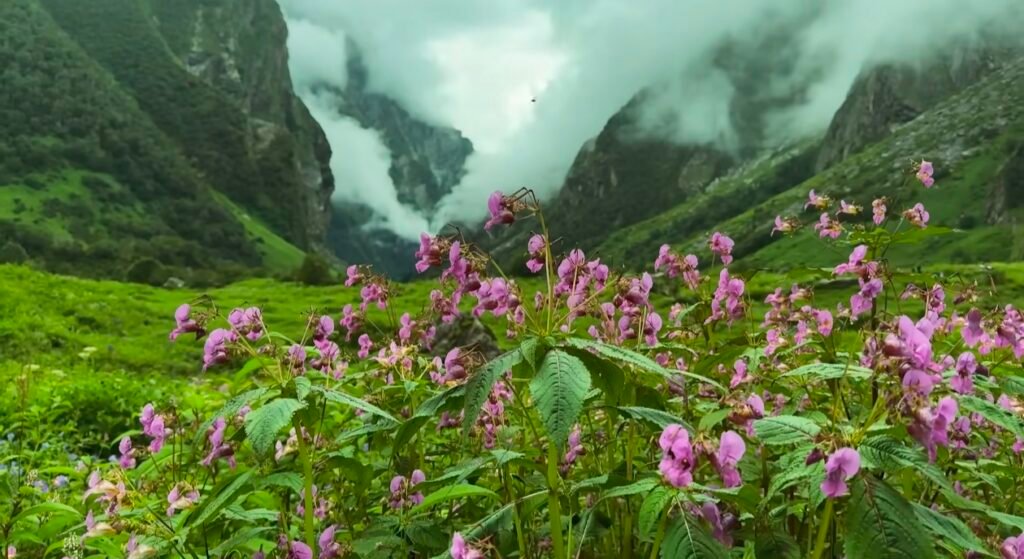
In 1931, British mountaineer Frank Smythe stumbled upon this valley and called it a “paradise on Earth.” Its UNESCO status protects its unique ecosystem, filled with rare plants and animals. The lack of direct road access makes it feel like a hidden gem, perfect for adventurers.
Planning Tip: Start from Haridwar or Rishikesh at 5–6 AM to reach Govindghat by evening. Rest overnight before trekking to avoid fatigue.
Ideal 6-day itinerary to Valley of Flowers trek for 2025
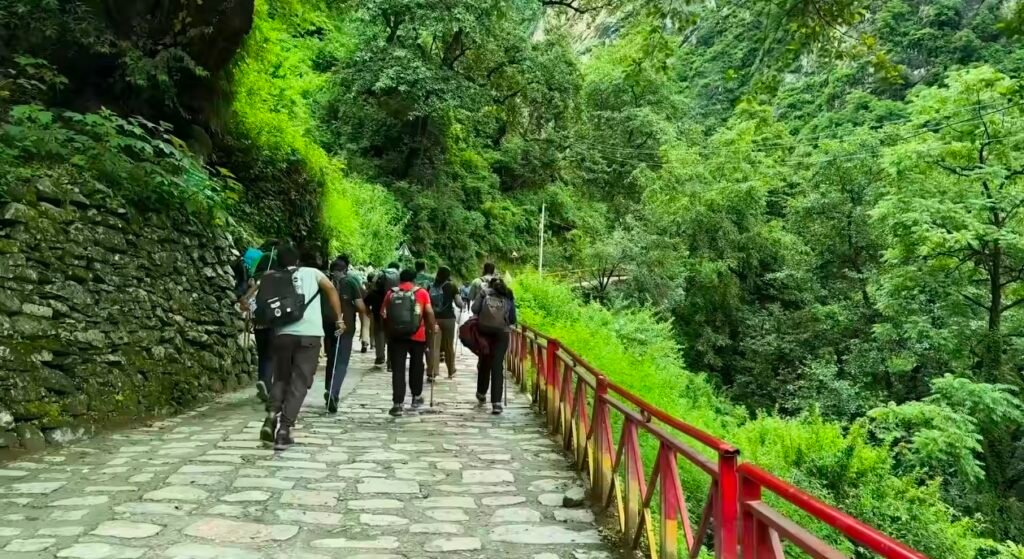
This 6-day itinerary ensures a relaxed pace with acclimatization:
Day 1:
The journey begins with a long drive from Haridwar to Govindghat, covering approximately 8 to 10 hours by bus or taxi. Govindghat is situated at an elevation of 6,000 feet. Upon arrival, travelers can find accommodations in local hotels ranging from ₹500 to ₹1,500 per night. You can also visit the nearby Pandukeshwar Temple for a cultural touch.
Day 2:
On the second day, the journey continues from Govindghat to Ghangaria, located at around 10,000 feet. First, take a short 10 km drive to Pulna, which is the starting point of the trek. From there, trek 10 km to Ghangaria, which typically takes 4 to 6 hours. Once in Ghangaria, it’s essential to rest and allow your body to acclimatize to the higher altitude.
Day 3:
This day is reserved for acclimatization in Ghangaria, still at 10,000 feet elevation. Travelers can take light walks, explore the local market, or visit the nearby Gurudwara to adapt comfortably to the altitude before the upcoming treks.
Day 4:
Day four is the highlight of the trip with a trek to the enchanting Valley of Flowers. The trek is 3.5 km one way and usually takes 2 to 3 hours to complete. Once there, spend about 4 to 5 hours exploring the lush meadows filled with vibrant, seasonal blooms. Afterward, return to Ghangaria for the night.
Day 5:
The fifth day includes a challenging yet rewarding trek to Hemkund Sahib, located at an altitude of 15,200 feet. The steep uphill climb is about 6 km and typically takes 3 to 4 hours. At the top, visit the sacred Gurudwara and the serene glacial lake. After spending time there, trek back down to Ghangaria.
Day 6:
On the final day, begin the descent from Ghangaria by trekking back to Pulna, which takes around 4 to 5 hours. From Pulna, drive back to Haridwar, a journey that takes 8 to 10 hours. You can also make a brief stop at the picturesque Vishnuprayag on your way back.
Alternative 4-Day Itinerary
- Day 1: Haridwar to Govindghat.
- Day 2: Govindghat to Ghangaria.
- Day 3: Valley of Flowers exploration.
- Day 4: Ghangaria to Haridwar. Note: Shorter itineraries increase AMS risk due to less acclimatization.
When is the Valley of Flowers trek Open in 2025?
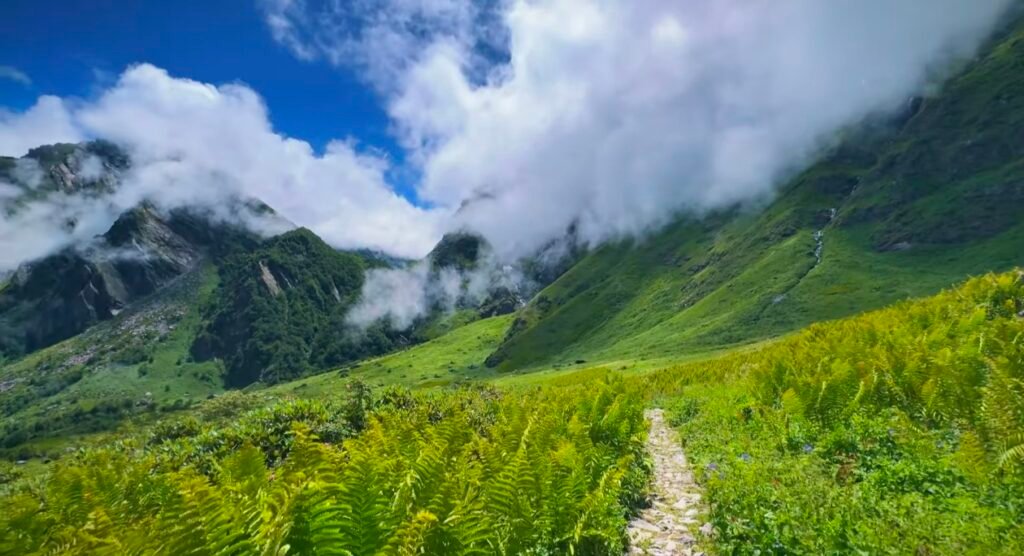
The valley is open only from June to October due to heavy snowfall in winter. For 2025, the tentative schedule is:
- Opening Date: June 1, 2025
- Closing Date: October 31, 2025
- Visiting Hours: 7:00 AM to 5:00 PM (last entry at 2:00 PM; start returning by 1:00 PM).
The rest depends on the weather. Valley of flowers may sometimes open a little late from June 1, but this happens very rarely. It depends on the weather and snowfall.
If there is a lot of snowfall in winter, the snow melts late, which takes time to clear the path. For safety reasons, the park is opened only when the trekking route is completely safe.
Usually Valley of Flowers trek opens around June 1 every year. But if the weather is bad, it may open 5-10 days late. If you are planning a trip, then do get updates from the government website or the local tourism office.
Valley of Flowers trek closes every year around the end of October i.e. October 31. This is because it is very cold here in October and snowfall starts, due to which trekking and walking are not free from danger. Due to snowfall and bad weather, the paths are closed and the valley becomes unsafe, so the valley is closed for the safety of tourists.
Booking Tip: Reserve permits and accommodation 1 – 2 months in advance for July–August, when daily visitors can reach 1,000.
Best Time to Visit the Valley of Flowers trek
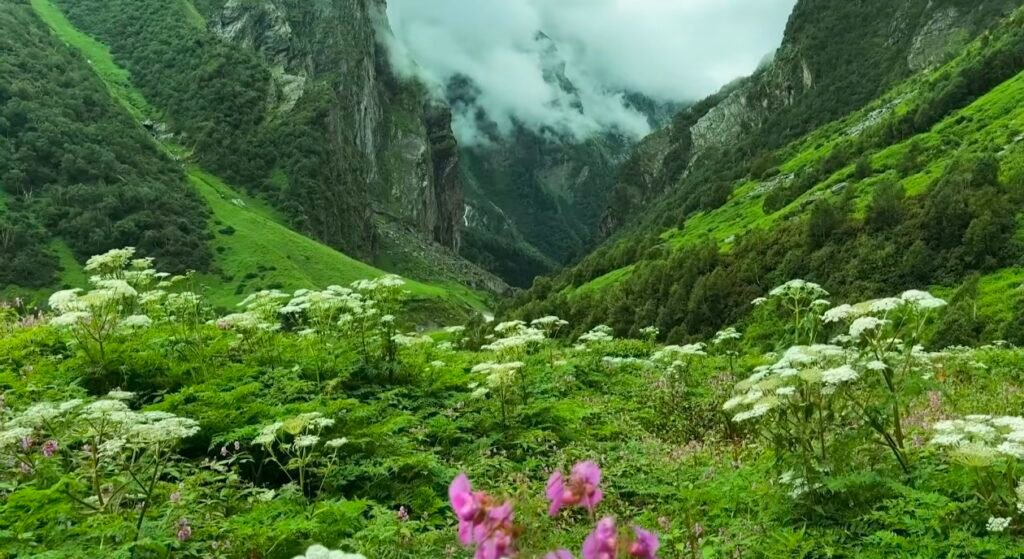
The valley is most beautiful during the monsoon, when flowers bloom in vibrant colors. The best time to visit is mid-July to mid-August, when the meadows are a rainbow of blooms. Here’s a detailed guide:
Valley of Flowers Trek: Month by Month Experience
If you’re planning to visit the Valley of Flowers, here’s what you can expect during each month—explained in easy English and paragraph style.
In June, you’ll find fresh green meadows and patches of leftover snow from winter. This is the time when the first flowers like primulas and anemones start blooming. The weather remains cool, with temperatures between 5–15°C, and sometimes it rains lightly. Not many people visit this month, usually just 200–300 each day, so it feels peaceful. The scenery is a mix of snow-capped mountain peaks and early flowers—a great time for quiet photography.
July marks the real beginning of the blooming season. More flowers come alive, including bright blue poppies and orchids. The crowd picks up, with around 500–700 visitors each day. The weather is rainy and a bit warmer (8–18°C), and the trails can get slippery and foggy. You’ll see early blooms and lots of misty, enchanting views, which makes it perfect for unique landscape photos.
In August, the valley is at its most colorful and lively. This is when the maximum number of flowers bloom, including the famous Brahma Kamal and pretty daisies. The area gets crowded (800–1,200 visitors daily), and there are heavy rains (5–20°C). The paths might be muddy, but the fields turn into vibrant carpets of flowers. This is the best month if you want to see the valley in full bloom and take stunning photos filled with color.
September brings fewer flowers, but on the bright side, you get clearer skies and the valley stays lush and green. Visitor numbers drop back to 200–400 a day, so it’s quieter again. The weather becomes cool (5–15°C) and there’s not much rain. You’ll enjoy clear views of the mountains and lots of greenery, which is perfect for those who love peaceful landscapes.
By October, most of the flowers are gone, but the majestic Himalayan peaks stand out even more. Hardly anyone visits now (only 50–100 people a day). The air turns cold (0–10°C), and the skies are usually very clear. This is the perfect time for crisp, sharp photos of the mountains and valleys.
Why Mid-July to Mid-August?
This is when flowers like Brahma Kamal and Blue Poppy are at their peak, creating a stunning display. However, expect crowds (especially weekends) and rain, so pack waterproof gear and start treks early (6–7 AM).
Best Time to Visit Valley of Flowers trek for Different Travelers (Simple & Short)
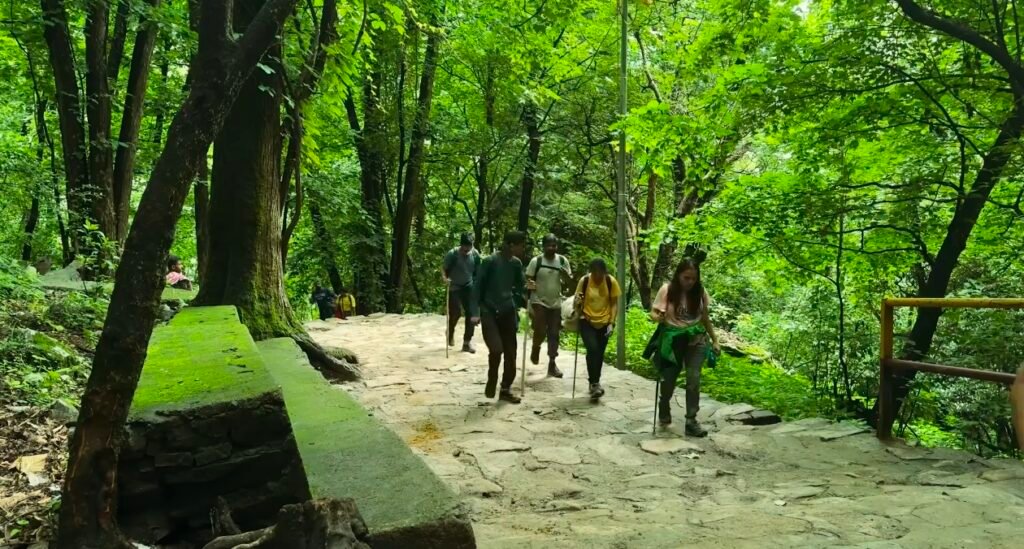
👉 Families with Kids:
The best time is mid-July to mid-August. During this time, the valley is full of colorful flowers and the weather is pleasant. The trek is not too hard, and ponies or porters are available if kids or elders get tired. Avoid early June (due to snow) and late October (too cold).
👉 Nature Lovers & Photographers:
Visit in July or August when the maximum number of flowers bloom. The valley looks like a garden of colors, and it’s perfect for taking beautiful photos and enjoying nature.
👉 Trekkers & Peace Seekers:
For quiet and fewer crowds, late June or early September is a great time. The weather is cooler, and you get a peaceful experience of the valley.
👉 Elderly Travelers:
Mid-July to early August is ideal as the weather is not too cold, and support like ponies or palanquins is available.
Summary:
- July–August is best for families, kids, and flower lovers.
- Late June or early September is good for trekkers or those who want peace.
- Avoid October end due to cold and no flowers.
Always check the weather and trail before going, and plan your trip accordingly!
Traveler Story: In July 2024, I went on a solo trip to the Valley of Flowers, and it was truly magical. The trek from Govindghat to Ghangaria was peaceful, and entering the valley felt like stepping into a dream—endless colorful flowers, fresh mountain air, and pure silence. Walking alone allowed me to connect deeply with nature. I spent hours exploring, capturing photos, nature filmmaking and enjoying the calm. For anyone who loves solo travel and nature, this place is a must-visit in July.
Is the Valley of Flowers Trek Worth It?
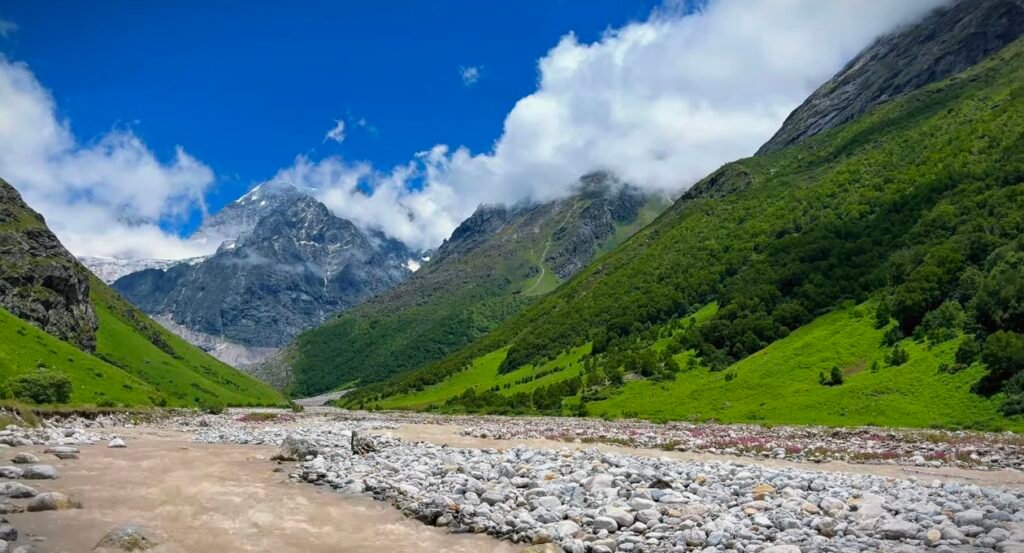
Yes, it’s a once-in-a-lifetime experience! Here’s why:
- Unique Flora: Over 600 flower species, many rare and endemic.
- Stunning Scenery: Snowy peaks, waterfalls, and the Pushpawati River.
- Spiritual Touch: The nearby Hemkund Sahib Gurudwara adds a cultural element.
- Accessible for Beginners: Moderate difficulty suits most fitness levels.
- Eco-Friendly: Strict rules keep the valley pristine.
Challenges: Monsoon rains, high altitude, and basic facilities in Ghangaria may test some travelers. But the breathtaking beauty makes every step worthwhile.
Traveler Insight: A 2024 TripAdvisor review said, “The flowers were unreal, like a dream. The trek was tough but worth every moment!”
How Difficult is the Valley of Flowers Trek?
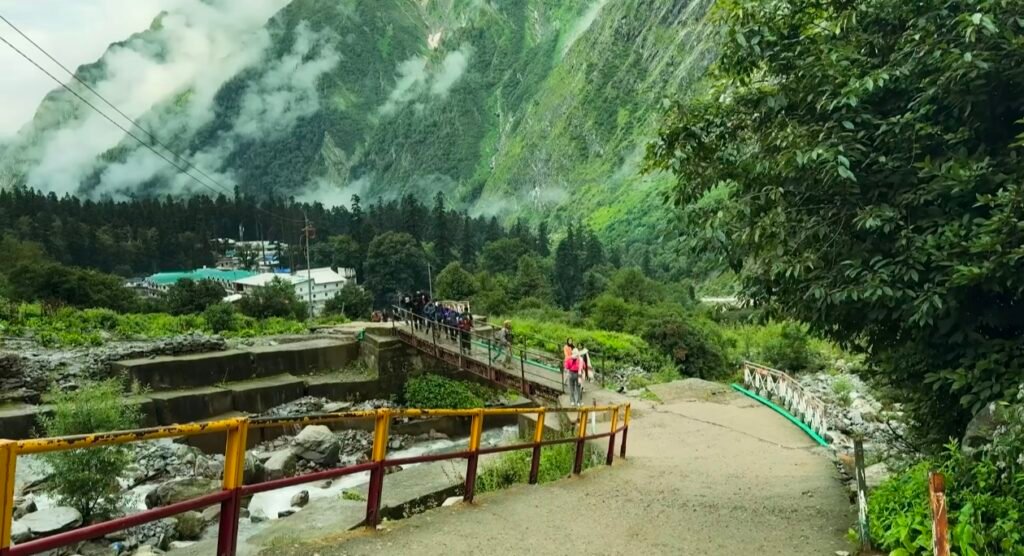
The trek is easy to moderate, perfect for beginners with basic fitness. Here’s a detailed overview:
- Total Distance: 34–38 km round trip (Govindghat to Valley of Flowers and back).
- Route Breakdown:
- Govindghat to Pulna: 10 km (by road, 30–60 minutes).
- Pulna to Ghangaria: 10 km (trek, 4–6 hours, 1,200 m elevation gain).
- Ghangaria to Valley of Flowers: 3.5 km (trek, 2–3 hours one way, 350 m elevation gain).
- Trail Conditions: Stone paths are well-marked but can be muddy, slippery, or rocky during monsoon. The trail includes forest paths, stream crossings, and a bridge over the Pushpawati River.
- Altitude Range: 6,000 ft (Govindghat) to 12,000 ft (Valley of Flowers).
- Fitness Required: Ability to walk 6–8 km daily and handle high altitude.
Trekker Comparison
When planning a Valley of Flowers trek, it’s important to consider your trekking experience and physical capacity, as well as your companions. Here’s a comparison of trekker types in easy paragraph style:
Beginners generally cover 6–8km per day. They should expect a slower pace with frequent breaks to adjust to the mountain environment. To prepare, beginners are advised to practice by walking 5–6km daily before the trek, use trekking poles for extra stability, and spend time acclimatizing in Ghangaria to avoid altitude sickness.
Experienced trekkers can comfortably traverse 10–14km in a day and are usually at ease with the altitude and terrain. They often explore deeper trails in the valley and benefit from carrying light gear to maximize mobility and comfort during longer walks.
Kids (aged 7 and above) typically manage 4–6km per day but need close supervision throughout the trek. It’s recommended for kids to use ponies for extra support and to take frequent breaks. The route to Hemkund Sahib should be avoided for them due to its challenging incline and altitude.
This comparison helps you tailor your trek plan based on the group’s fitness and experience, making sure everyone enjoys the Valley of Flowers safely and comfortably.
Altitude Sickness (AMS) Risks
At 12,000 feet, AMS can cause headaches, nausea, dizziness, or fatigue. To prevent it:
- Spend 1–2 days in Ghangaria (10,000 ft) to acclimatize.
- Drink 3–4 liters of water daily.
- Avoid alcohol and smoking.
- Consult a doctor about Diamox (125 mg twice daily, start 24 hours before ascent).
- Carry a portable oxygen canister (₹500–1,000, available in Joshimath).
Trail Challenges
- Monsoon Conditions: Heavy rain (July–August) makes trails slippery. Wear high-ankle trekking shoes (e.g., Quechua Forclaz 500, ₹5,000–7,000).
- Steep Sections: Pulna to Ghangaria has gradual inclines; Hemkund Sahib (6 km, 1,200 m gain) is steep.
- Weather: Sudden fog or rain reduces visibility. Start treks by 6–7 AM.
Traveler Tip: My trekking poles were a lifesaver on muddy trails. Don’t skip them!”
How to Prepare for the Valley of Flowers Trek
Physical Preparation
- Cardio: Walk or jog 5–6 km daily for 4 – 5 weeks. Add stair climbing to build leg strength.
- Strength Training: Do squats, lunges, and calf raises (3 sets of 15 reps, 3 times/week) for steep trails.
- Altitude Prep: Practice deep breathing (10 minutes daily) to boost lung capacity. If possible, trek at 2,000–3,000 m (e.g., Mussoorie) before the trip.
- Fitness Test: Can you walk 10 km in 2–3 hours with a 10 kg backpack? If not, train more.
Mental Preparation
- Watch YouTube videos Valley of Flowers trek series) to visualize the trek.
- Join trekking communities on for tips from past trekkers.
- Prepare for basic facilities (no Wi-Fi, limited electricity) and monsoon challenges.
Gear Testing
- Break in trekking shoes 2–3 weeks before to avoid blisters.
- Test a 30–40L backpack with 10–12 kg weight on practice hikes.
- Practice using trekking poles for balance on uneven terrain.
Preparation Timeline
- 3 Months Before: Start cardio and strength training.
- 1 Month Before: Test gear, book permits, and accommodation.
- 1 Week Before: Check weather (Windy or IMD apps), pack essentials, consult doctor for AMS medication.
Transport Options to Reach the Valley
The journey involves road travel and trekking. Here’s a detailed guide:
- Govindghat to Pulna (10 km):
- Shared Jeep: ₹50–100 per person, 30–60 minutes.
- Private Taxi: ₹500–800 one way.
- Walking: Not recommended due to dusty roads and traffic.
- Pulna to Ghangaria (10 km):
- Trekking: 4–6 hours, moderate climb through pine forests and villages.
- Pony: ₹800–1,200 one way (book at Pulna checkpost).
- Porter: ₹500–800 for 10–15 kg bags.
- Doli (Palanquin): ₹2,000–3,000 one way, ideal for kids or elderly.
- Helicopter: Seasonal service (₹3,500–5,000 one way, 5–7 minutes). Book via GMVN or Heritage Aviation.
- Ghangaria to Valley of Flowers (3.5 km):
- Trekking Only: 2–3 hours one way; no ponies or dolis beyond the valley gate.
- Doli: Available up to the gate (₹1,500–2,000).
- Optional Hemkund Sahib Trek (6 km from Ghangaria):
- Steep climb to 15,200 feet; 3–4 hours uphill, 2–3 hours down.
- Ponies (₹1,000–1,500) and dolis (₹2,500–4,000) available.
- Gurudwara offers free langar (dal, rice, roti) and tea.
Booking Transport
- Ponies/Dolis: Negotiate at Pulna or Ghangaria; prices rise 20–30% in peak season.
- Helicopters: Book via gmvnonline.com or private operators. Check weather updates, as flights cancel frequently.
- Taxis: Pre-book in Haridwar/Rishikesh via agencies.
Traveler Tip: “Helicopters were grounded due to fog. Always have a trekking plan as backup!”
Valley of Flowers trek entry fee and permits in 2025
A permit is required at the Ghangaria forest checkpost. Fees for 2025 are:
For visiting the Valley of Flowers, Indian visitors are required to pay ₹150 for a 3-day permit, and an additional ₹50 for each extra day they wish to stay. In comparison, foreign nationals are charged ₹600 for the 3-day permit, with an extra charge of ₹250 for every additional day beyond the initial period. These charges allow for flexible trip planning, whether you are staying for just a few days or extending your visit to explore more of the park.
Permit Process
- In-Person: Show ID proof (Aadhar, Passport, Voter ID, or Driver’s License) at the checkpost (7:00 AM–2:00 PM).
- Online: Book via valleyofflower.uk.gov.in or agencies Carry a printed/digital copy.
- Peak Season: Expect 30–60 minute queues in July–August. Pre-book to save time.
Additional Fees
- Camera: ₹50–100 for professional cameras/videography.
- Hemkund Sahib: No separate permit, but a medical certificate is advised.
Tip: Carry 2–3 photocopies of ID proof for quick processing.
Know which documents are necessary to go to Valley of Flowers trek
- Permit: Mandatory for valley entry; carry printed/digital copy.
- ID Proof: Aadhar, Passport, Voter ID, or Driver’s License.
- Medical Certificate: Recommended for Hemkund Sahib (consult doctor).
- Travel Insurance: Optional (₹500–1,500, covers accidents). Check Policybazaar or TrekSafe.
- Emergency Contact: Note with family/emergency numbers.
Is the Valley of Flowers Trek Safe for Kids, Elderly, and Solo Travelers?
- Kids (7+ years): Safe with adult supervision. Use ponies/dolis for Pulna–Ghangaria. Avoid Hemkund Sahib for kids under 10.
- Elderly: Consult a doctor for high-altitude clearance. Dolis are ideal for less mobile trekkers. Hemkund Sahib is strenuous.
- Solo Travelers: Safe, but join group treks for safety and companionship. Hire certified guides (₹1,000–2,000/day).
Safety Measures
- Acclimatize in Ghangaria for 1–2 days to reduce AMS risk.
- Carry a portable oxygen canister (₹500–1,000) and first aid kit. It is not that important but if you want to keep it then you can keep it
- Trek in groups during monsoon for safety on slippery trails.
Packing Checklist for the valley of flowers Trek
When preparing for the Valley of Flowers trek, it’s crucial to pack efficiently and thoughtfully so you’re ready for the weather and terrain. Here is a detailed packing checklist described in paragraph style for clarity:
Begin with your clothing essentials: You will need a raincoat or poncho to protect against unexpected showers and thermal base layers (preferably two sets) to stay warm during chilly nights when temperatures can dip between 0–5°C. Choose quick-dry trekking pants and shirts for comfort on the trail, and don’t forget a woolen cap and gloves for cold mornings and evenings. Pack 4–5 pairs of woolen or cotton socks and a fleece jacket for extra insulation.
Moving on to trekking gear, opt for waterproof, high-ankle trekking shoes from trusted brands like Quechua or Salomon for grip and support on slippery or rocky paths. Carry a pair of trekking poles for stability on steep slopes, a 30–40L waterproof backpack for your main gear, and a smaller 10L daypack for essentials during short hikes. Bring a headlamp with extra batteries, as power outages are common in the mountains.
Health and safety items are equally important. Pack a basic first aid kit containing bandages, antiseptic, and painkillers, as well as personal medications you may need. Oral rehydration salts (approximately 10 packets) are helpful in case of dehydration, and Diamox can be considered (after medical advice) to prevent altitude sickness. Use a high SPF sunscreen (at least SPF 50) and lip balm to guard against the strong Himalayan sun, and bring insect repellent to ward off bugs.
Under other essentials, a 10,000 mAh power bank will keep your devices charged, while two copies of your ID proof ensure you can complete official formalities and travel checks. An emergency whistle is useful for signaling if needed, and UV-protective sunglasses shield your eyes from harsh sun glare. Pack a reusable water bottle (1–2L) to stay hydrated, a camera to capture beautiful moments, and a rain cover for your backpack to protect your belongings during rain showers.
Packing all these items will help ensure you are well-prepared, comfortable, and safe, allowing you to fully enjoy the incredible beauty of the Valley of Flowers trek.
Packing Hacks
- Keep backpack weight under 10–12 kg.
- Use ziplock bags for electronics to protect from rain.
- Carry extra socks and quick-dry clothes for wet conditions.
- Test gear on short hikes to ensure comfort.
Food and Accommodation Options in Valley of Flowers trek
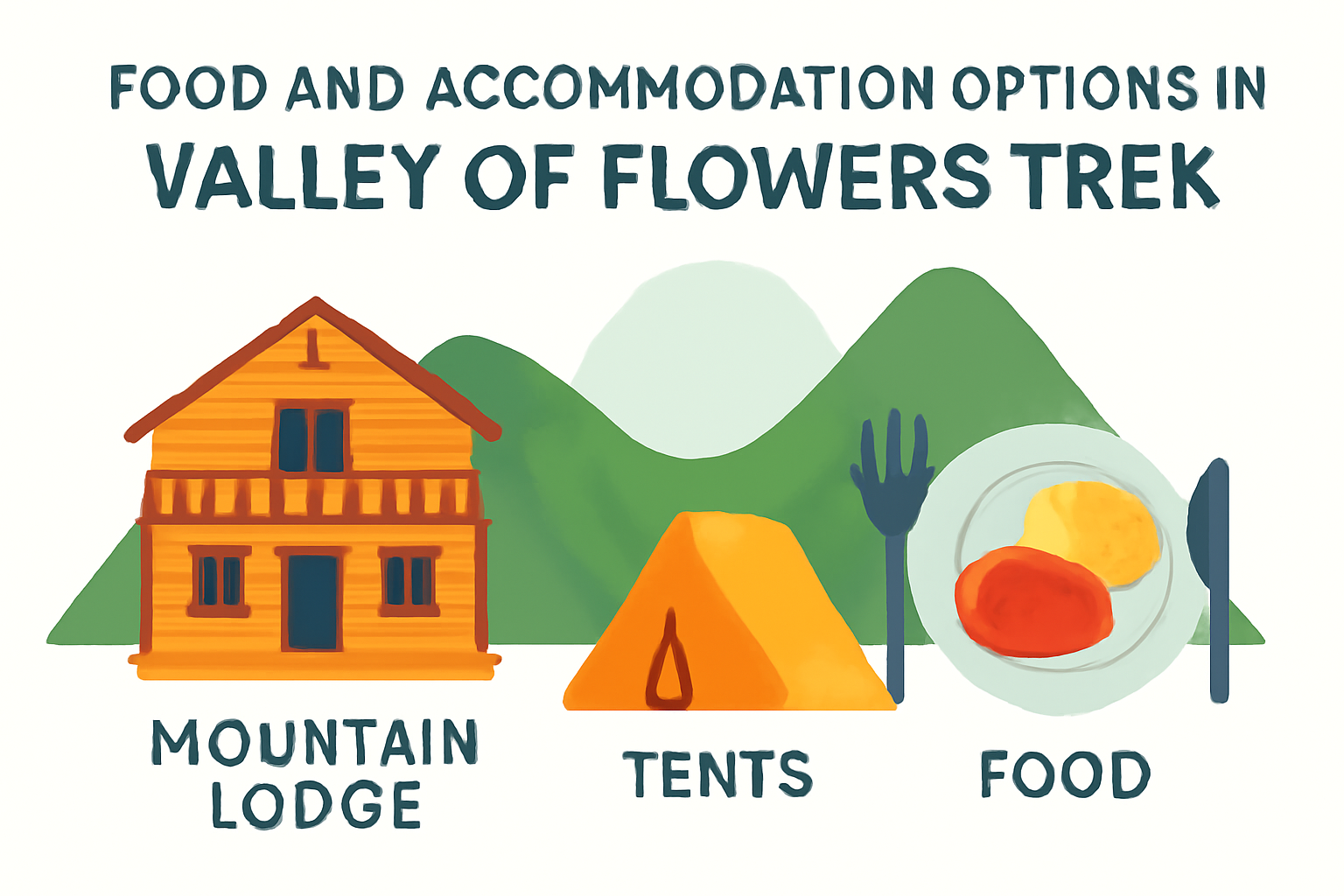
Food in Ghangaria
- Dhabas: Serve dal-rice, roti-sabzi, Maggi, tea, parathas (₹100–200/meal).
- Gurudwara: Free langar (dal, rice, roti) at Ghangaria and Hemkund Sahib.
- Trek Snacks: Carry nuts, energy bars, chocolates, dry fruits (₹500–1,000 budget)
- Water: Refill from valley streams (boil or use purifiers like Steripen, ₹2,000). Carry 2 liters daily.
Accommodation
- Budget Hotels: ₹300–800/night (basic rooms, shared bathrooms).
- Dharamshalas: ₹100–300/person (shared dorms).
- GMVN Guest Houses: ₹500–1,200/night (book via gmvnonline.com).
- Peak Season: Book 2–3 months in advance for July–August.
Cash Requirements
- No ATMs or digital payments beyond Joshimath (40 km).
- Carry ₹6,000–8,000 in cash (small denominations: ₹50, ₹100).
- Budget ₹500–1,000 for tips and emergencies.
Tip: Withdraw cash in Haridwar, Rishikesh, or Joshimath. ATMs in Joshimath may run out.
Connectivity and Charging
- Mobile Network: Only BSNL and Jio work in Ghangaria (weak signal). No network in the valley or Hemkund trail.
- Internet: Limited Wi-Fi in hotels (₹50–100/day, unreliable).
- Charging: Budget hotels lack charging points. Carry a 10,000 mAh power bank (₹1,000–2,000).
Weather and Emergency Tips
- Temperature: Day: 5–20°C; Night: 0–5°C.
- Monsoon Risks: Heavy rain, fog, landslides (July–August). Trails may close for 1–2 days.
- Weather Tools: Use Windy (windy.com) for updates. Download offline forecasts.
- Emergency Services:
- Medical: Dispensary in Ghangaria; hospital in Joshimath (40 km, ₹500–1,000 taxi).
- Support: Forest checkposts and Eco Development Committees assist.
- Helpline: 108 (Uttarakhand ambulance); +91-135-2710334 (GMVN).
Emergency Gear
- Portable oxygen canister (₹500–1,000).
- Emergency whistle (₹50–100) and torch (₹200–500).
- Offline maps (Maps.me, Google Maps).
It is not so important but still if you want then you can take care of your own safety
How many types of flowers and medicinal plants will we get to see in the Valley of Flowers trek
The Valley of Flowers trek hosts over 600 flower species, with 31 endangered (Wildlife Institute of India). Key plants include:
- Brahma Kamal (Saussurea obvallata): Sacred, blooms at night, used in Ayurveda for respiratory issues.
- Blue Poppy (Meconopsis aculeata): Rare, vibrant blue, peaks in July–August.
- Impatiens Sulcata: Crimson-pink, abundant in August.
- Primulas, Bellflowers, Orchids: Colorful meadow carpets.
- Medicinal Plants: Aconitum (pain relief), Allium (antiseptic), Saussurea costus (digestive issues).
Best flower viewing spots in Valley of Flowers trek
- Pushpawati Riverbank: Blue poppies and primulas.
- Central Meadow: Brahma Kamal and orchids (August).
- Valley End (near glacier): Rare species like Saussurea simpsoniana.
Wildlife Watching at Valley of Flowers trek
The valley is home to rare Himalayan wildlife:
- Himalayan Musk Deer: Shy, musky-scented, seen at dawn.
- Bharal (Blue Sheep): Found on rocky cliffs.
- Himalayan Monal: Colorful bird with iridescent feathers.
- Rare Sightings: Asiatic black bear, snow leopard (rare).
Wildlife Tips
- Use binoculars (₹2,000–5,000) for safe spotting.
- Trek early (6–8 AM) for better sightings.
- Join guided wildlife tours (₹1,500–3,000).
Environmental Rules and Regulations in Valley of Flowers trek
Strict rules protect the valley’s ecosystem:
- No Plastic: Banned (fines ₹1,000–5,000). Use reusable bottles.
- No Littering: Carry waste back to Ghangaria.
- No Smoking or Loud Music: Keep the valley peaceful.
- Stay on Trails: Avoid trampling plants or picking flowers.
- Random Checks: Forest officials inspect bags.
Penalty: Fines up to ₹5,000 or trekking bans.
Safety tips for solo travellers and women in Valley of Flowers trek
- Group Treks: Join agencies like IndiaHikes or Thrillophilia (₹8,000–14,000).
- Guides: Hire certified local guides (₹1,000–2,000/day).
- Women-Specific Tips:
- Trek with groups like WOW (Women on Wanderlust).
- Carry pepper spray (₹200–500).
- Stay in GMVN guest houses (check reviews).
Best Travel Agencies for Valley of Flowers Trek
IndiaHikes offers packages ranging from ₹9,000 to ₹12,000. Their trekking cost includes experienced guides, meals throughout the trek, and all necessary permits. This agency is especially known for its eco-conscious practices and well-trained guiding staff, making it an ideal choice for environmentally minded trekkers seeking expertise on the trail.
Thrillophilia provides Valley of Flowers trek packages costing ₹8,000 to ₹10,000. The cost covers all meals, permits, and group trek arrangements. Thrillophilia is popular for its budget-friendly rates and the flexibility to customize your trekking experience, making it a great pick for those who want good value and personalization.
Trek The Himalayas has packages priced between ₹10,000 and ₹14,000, which include professional guides, comfortable stays during the trek, and insurance coverage. They are well-regarded for offering thoroughly planned itineraries with a special focus on safety, appealing to trekkers who want assurance and detailed planning.
GMVN (Garhwal Mandal Vikas Nigam) offers the most affordable trekking packages, ranging from ₹7,000 to ₹10,000. Their packages include basic accommodations and trek permits. As a government-run organization, GMVN is seen as especially reliable and is often chosen by budget-conscious travelers looking for trusted services.
Choosing an Agency
- Check reviews on social media, or Google.
- Ensure permits, meals, and insurance are included.
- Ideal guide-to-trekker ratio: 1:10.
Extra Attractions Near the Valley of Flowers trek
Here are the major attractions near the Valley of Flowers with approximate distances
- Hemkund Sahib
Approximately 6 km trek from the Valley of Flowers via Ghangaria. It is a steep trek uphill from Ghangaria, which is the base village. - Ghangaria (Base Village)
About 4 km trek from the Valley of Flowers. Ghangaria is the last human settlement before the Valley and Hemkund Sahib. It is accessible by a 13–14 km trek from Govindghat via Pulna. - Govindghat (Main Roadhead)
Located roughly 17–18 km from the Valley of Flowers combining road travel and trekking via Pulna and Ghangaria. Govindghat is the main parking and transportation hub for visitors heading to the Valley. - Badrinath Temple
Around 25 km by road from Govindghat. Badrinath is a famous Hindu pilgrimage site situated beyond the trekking route and is accessible by vehicle. - Mana Village
About 3 km by road from Badrinath. Known as the last Indian village near the Tibet border, it is rich in mythology and natural beauty. - Joshimath (Gateway Town)
Approximately 22 km by road from Govindghat. Joshimath is the nearest major town and transit point for travelers heading into the Valley of Flowers region. - Nanda Devi National Park
Adjacent to the Valley of Flowers, forming part of the same UNESCO World Heritage site. It is accessible for nature enthusiasts, though direct trekking routes vary. - Pulna Village
Around 4 km drive from Govindghat, Pulna is the starting point of the main trek toward Ghangaria and the Valley of Flowers.
Distances are approximate and based on common trekking routes; actual distances may vary depending on weather and trail conditions.
Best Photography Spots in the Valley of Flowers trek
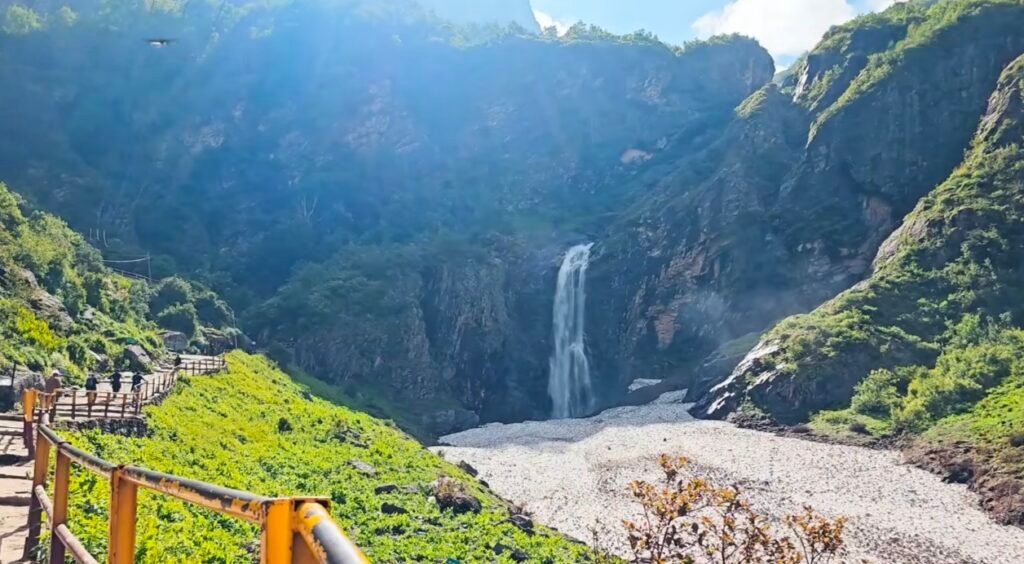
- Pushpawati Riverbank: Blue poppies with river backdrop.
- Central Meadow: Wide-angle flower shots.
- Valley End: Rare flowers and glacier views.
- Hemkund Sahib Lake: Reflective lake with Brahma Kamal.
Photography Tips
- Use a DSLR/mirrorless camera (Canon EOS 200D, with a 24–70mm lens.
- Carry a polarizing filter (₹1,000–2,000) for vibrant colors (optional )
- Shoot in early morning light (6–8 AM).
- Bring extra batteries or powerbanks, no charging in the valley.
Sample Budget Breakdown for 2025
For a 6-day affordable trip to the Valley of Flowers, your primary expenses will include transportation, accommodation, food, permits, and some miscellaneous charges.
Transport from Haridwar to Govindghat and back generally costs between ₹1,500 to ₹2,000 per person, whether you opt for a bus or a shared taxi. For your stay, plan a budget of ₹1,500 to ₹2,500 for 5 nights, as budget hotels and government guesthouses (GMVN) are available in Govindghat and Ghangaria. Food and snacks usually require ₹1,500 to ₹2,000, with most meals on the trek priced between ₹100–200 per meal, plus the cost of some trek snacks.
To enter the Valley of Flowers, Indians need to pay an entry fee of ₹150, while foreigners are charged ₹600. Expect permit and entry expenses to be in the range of ₹150–300 overall. Additional miscellaneous costs, like hiring a pony, giving tips, or handling emergencies, often sum up to around ₹800 to ₹1,200.
Altogether, you should budget approximately ₹5,450 to ₹7,800 for an affordable 6-day Valley of Flowers trek, covering all essential needs. This ensures you travel comfortably without overspending during your adventure.
Budget-Saving Hacks
- Share rooms (₹150–300/person).
- Book group treks for 10–20% discounts.
- Carry homemade snacks to save ₹500–1,000.
Valley of Flowers Trek Cost Breakdown
- Solo Trek: ₹5,000–8,000 (self-organized).
- Group Trek: ₹8,000–14,000 (with agency).
- Luxury Trek: ₹15,000–20,000 (private guides, premium stays).
- Less budgets If you have a low budget then your trek can be done in 2500 to 3000 rupees. This budget is from Haridwar, and food and stay will be available in Gurudwara only
FAQs About the Valley of Flowers Trek
1. Can I Trek Valley of Flowers with Limited Mobility?
Yes, but challenging. Use dolis (palanquins, ₹2,000–3,000) from Pulna to Ghangaria. The final 3.5 km to the valley has uneven paths, so consult a doctor and hire a guide (₹1,000–2,000/day) for support.
2. Are There Age Limits for the Trek?
No strict limits. Kids (7+) need supervision, and elderly travelers (60+) require a doctor’s clearance due to 12,000 ft altitude. Use ponies/dolis (₹800–3,000) for easier access.
3. Can I Do the Valley of Flowers Trek in One Day?
No, the 34–38 km round trip from Govindghat requires 2–3 days minimum, including acclimatization in Ghangaria to avoid AMS risks.
4. Are Local Guides Available in Ghangaria?
Yes, certified guides at Pulna/Ghangaria (₹1,000–2,000/day) know trails and flora. Book via GMVN or agencies like Trek The Himalayas for expertise.
5. What’s the Maximum Group Size for the Trek?
Group treks (e.g., IndiaHikes) allow 10–25 people for safety and eco-compliance. Large groups (20+) need forest department approval. Solo trekkers can join groups at Ghangaria checkpost.
6. Are There Rest Points on the Trek?
Yes, benches and shade at Pulna, Bhyundar Village, and every 1–2 km on the Ghangaria–Valley trail. Tea stalls (₹20–50/tea) offer quick breaks.
7. Can I Buy Trekking Gear in Govindghat or Ghangaria?
Yes, Govindghat has raincoats, sticks, ponchos (₹100–500). Ghangaria has limited options. For quality gear (shoes, backpacks), shop in Haridwar/Rishikesh (Decathlon, ₹2,000–7,000).
8. Is There a Daily Visitor Limit for the Valley?
There is currently no daily visitor limit at the Valley of Flowers. However, to protect its fragile ecosystem, a limit of around 300 visitors per day has been proposed. This rule has not been implemented yet.
9. Can I Trek Valley of Flowers in Winter (November–May)?
No, the valley is closed due to snow and unsafe trails (-10°C). Plan for June–October.
10. Are There Guided Flora Tours in the Valley?
Yes, botanist-led tours (₹2,000–4,000/day) focus on rare flowers like Brahma Kamal.
11. What’s the Local Culture Like Near the Valley?
Bhyundar Village and Ghangaria feature Garhwali culture: wooden homes, festivals (e.g., Nanda Devi Raj Jat, August), and cuisine (mandua roti, ₹50–100). Respect locals by avoiding loud music.
12. Can I Volunteer for Conservation in the Valley?
Yes, Eco Development Committees (EDC) in Ghangaria offer trail maintenance/cleanup programs (₹500–1,000/day, includes stay). Contact GMVN or uttarakhand tourism
13. Are There Festivals During the Trek Season?
Yes, small fairs in Bhyundar (August) and Sikh festivals at Hemkund Sahib (July–August). The Nanda Devi Raj Jat (every 12 years) is next in 2037.
14. Can I Trek on a Budget Under ₹5,000?
Possible but tight:
Shared transport: ₹1,000–1,500.
Dharamshalas: ₹500–1,000.
Food (langar, snacks): ₹500–1,000.
Permit: ₹150. Total: ~₹3,150–4,650. Share rides and stay to save
15. Are There Restrictions on Photography?
No flash or tripods to avoid disturbing wildlife. Drones are banned (fines ₹5,000). Pay ₹50–100 for professional cameras at checkpost.
16. Can I Get a Refund on Permits if I Cancel?
No refunds for permits (₹150–600). Book closer to your date or transfer via valleyofflowers.hemkunt.in.
17. Are There Trekking Apps for Valley of Flowers?
Use Maps.me or AllTrails for offline trail maps. Download in Haridwar, as Ghangaria has no Wi-Fi. GMVN provides paper maps (₹50–100).
18. Can I Combine Valley of Flowers with Other Treks?
Yes, try:
Hemkund Sahib: 6 km from Ghangaria, steep.
Kagbhusandi Lake: 15 km from Bhyundar, advanced.
Kuari Pass: Starts from Joshimath, 5–6 days. Plan 8–10 days.
19. What Are Local Food Specialties in Ghangaria?
Try Garhwali mandua roti, chainsoo (black gram dal), jhangora kheer at dhabas (₹100–200). Gurudwara offers free langar.
20. What’s the Risk of Landslides on the Trek?
Moderate in July–August. Roads to Govindghat (Rishikesh–Joshimath) are prone to landslides. Check uttarakhandtourism.gov.in. Trek early to avoid afternoon rain.
21. Can I Trek with a Heart Condition?
Consult a cardiologist. High altitude (12,000 ft) is risky. Use dolis (₹2,000–3,000) and carry oxygen (₹500–1,000). Avoid Hemkund Sahib.
22. Are There Yoga or Meditation Spots in the Valley?
Yes, Central Meadow and Hemkund Sahib Lake are serene. Avoid loud activities. Guided sessions in Ghangaria (₹500–1,000) via GMVN.
23. Can I Buy Souvenirs Near the Valley?
Yes, Ghangaria/Govindghat shops sell shawls, wooden crafts (₹200–1,000). Joshimath has better variety (caps, ₹300–500).
24. Are There Clothing Restrictions?
Wear modest, weather-appropriate clothing (thermals, raincoats). Avoid bright colors that disturb wildlife. Cover shoulders/knees at Hemkund Sahib.
25. How to Handle Leeches on the Trek?
Common in monsoon. Wear high-ankle boots, tuck pants into socks, apply salt or repellent (₹100–200). Check legs after trekking.
26. How to Get Real-Time Weather Updates?
AccuWeather, Weather.com, or IMD (India Meteorological Department): These platforms provide hourly and daily forecasts for Ghangaria (the base camp for Valley of Flowers treks)
Specialized Mountain Weather Apps: Apps like Windy or Mountain Forecast offer detailed alpine weather predictions, including precipitation, wind, and temperature trends
27. Can I Trek Without Prior Experience?
Yes, beginner-friendly (moderate). Train by walking 5–6 km daily for 4 weeks. Acclimatize in Ghangaria. optional Hire a guide (₹1,000–2,000/day) for safety.
28. What’s the Environmental Impact of Trekking?
Heavy footfall (1,000–1,500/day, July–August) risks trampling flora. Climate change shifts blooms earlier (June–July). Stick to trails, avoid littering (fines ₹1,000–5,000).
29. Are There Restrictions for Foreign Trekkers?
Foreigners need permits (₹600 for 3 days, ₹250/extra day) and passport. Register at Ghangaria checkpost. optional English-speaking guides (₹1,500–2,500/day) available.
30. How to Handle Medical Emergencies?
Ghangaria dispensary offers first aid, oxygen. Joshimath hospital (40 km, taxi ₹500–1,000). Carry first aid (₹200–500), Diamox, and medications. Helpline: 108.
31. Can I Extend My Stay in Ghangaria?
Yes, book extra nights (hotels ₹300–1,200). Explore Gorson Bugyal or revisit valley. Carry extra cash (₹2,000–3,000), no ATMs.
32. What Are Cultural Etiquette Tips for Visiting Hemkund Sahib?
Cover head (scarf provided), remove shoes, avoid indoor photography. Keep noise low, accept langar graciously, don’t waste food.
33. What Are the Risks of Trekking Alone?
Safe on marked trails, but risks include AMS, slippery paths, fog. Join groups (₹8,000–14,000) or hire guides. Carry whistle, offline maps.
34. Are There Local Myths About the Valley?
Locals believe fairies and deities inhabit the valley, linked to Nanda Devi myths. Pushpawati River is tied to Lakshman (Ramayana). Guides share Joan Margaret Legge’s story (botanist, died 1939).
35. Can I Do a Day Trip from Joshimath?
No, Joshimath to valley (22 km road + 13–14 km trek) needs 2–3 days. Plan a 4–6 day itinerary.
36. How to Avoid Crowds in Peak Season?
Trek Monday–Thursday in July–August (800–1,200 visitors/day). Start at 6 AM. Late June/September sees 200–400 visitors/day.
37. Are There Water Usage Restrictions?
Don’t pollute streams (fines ₹1,000–5,000). Refill from Pushpawati River (use purifiers, ₹2,000). No bathing in rivers.
38. Can I Trek with a Small Child (Under 7)?
Not advised due to 12,000 ft altitude and 3.5 km trek. For 7+, use ponies (₹800–1,200), consult pediatrician.
39. Is There a Risk of Getting Lost on the Trek?
Low risk; trails are well-marked with signboards. Fog in July–August may reduce visibility. Stick to paths, use offline maps (Maps.me), or hire a guide (₹1,000–2,000/day).
40. Can I Find English-Speaking Guides?
Yes, available in Govindghat/Ghangaria (₹1,500–2,500/day). Book via IndiaHikes or GMVN for fluent guides familiar with flora and trails.
41. Are There Any Restrictions on Fire or Cooking?
Yes, fires and cooking are banned in the valley to prevent forest fires and pollution. Use dhabas in Ghangaria (₹100–200/meal) or carry snacks.
42. Can I Trek During Heavy Rain?
Possible but risky. Heavy rain (July–August) makes trails slippery and increases landslide risk. Carry ponchos (₹100–200), start early (6 AM), and check IMD updates.
43. Are There Any Local Transport Options Within Ghangaria?
No vehicles in Ghangaria; it’s a trek-only village. Walk or use ponies (₹500–1,000) for short distances to trailheads.
44. Can I Find Vegetarian or Vegan Food in Ghangaria?
Yes, dhabas offer vegetarian dal-rice, roti-sabzi (₹100–200). Gurudwara langar is vegetarian. Vegan options are limited; carry nuts, dried fruits (₹500 budget).
45. What’s the Best Time for Birdwatching in the Valley?
Early morning (6–8 AM) in June–September. Spot Himalayan monal, griffon, and barbets. Use binoculars (₹2,000–5,000) and hire a wildlife guide (₹1,500–3,000).
Are there toilets on the valley of trek?
No, there are no toilets in the Upper Valley of Flowers
Can I visit Hemkund Sahib without the valley?
Yes, it’s a separate 6 km trek from Ghangaria.

